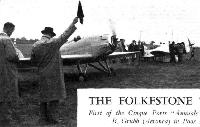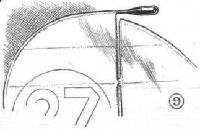
Hendy 281 Hobo и Hendy 302
Hendy 281 Hobo был построен в единственном экземпляре в Шорхэме, графство Сассекс, в 1929 году. Это был одноместный моноплан с низкорасположенным крылом и открытой пилотской кабиной. Первый полет он совершил в октябре 1929 года.
<...>
Описание:
- Hendy 281 Hobo и Hendy 302
- Flight, November 1929
THE "HENDY HOBO” - Flight, April 1930
AIRCRAFT FOR THE PRIVATE OWNER
Фотографии
-
Aeroplane Monthly 1977-06 / A.Ord-Hume - Hendy Hobo /British pre-war ultralights/
Регистрационный номер: G-AAIG [14] View of the Hobo in its original form, with 35 h.p. ABC Scorpion engine and large Palmer aero wheels.
-
Flight 1930-04 / Flight
Регистрационный номер: G-AAIG [14] -
Flight 1929-11 / Flight
Регистрационный номер: G-AAIG [14] The three photographs right show the Hobo at Shoreham in 1929, around the time of the first flight.
-
Air-Britain Archive 1980-02
Регистрационный номер: G-AAIG [14] From the same manufacturer, the one-off Hendy 281 Hobo G-AAIG is seen here at Hanworth where it was based with the owner Lord Patrick Crichton-Stuart, Feltham.
-
Aeroplane Monthly 1977-06 / A.Ord-Hume - Hendy Hobo /British pre-war ultralights/
Регистрационный номер: G-AAIG [14] Hendy "Hobo," Pobjoy "Cataract" 80 h.p. engine
The Hobo immediately after modifications which included re-engining with a Pobjoy R engine, different undercarriage and the fitting of mass balances to the ailerons and rudder. -
Aeroplane Monthly 1977-06 / A.Ord-Hume - Hendy Hobo /British pre-war ultralights/
Регистрационный номер: G-AAIG [14] The Hobo at Lympne, in later life.
-
Flight 1935-04 / Flight
Регистрационный номер: G-AAIG [14] The "Hobo" and the "Heck."
The Hobo after extensive modification, painted in the colours of Aircraft Exchange & Mart, at Hanworth.Другие самолёты на фотографии: Parnall Hendy Heck - Великобритания - 1934
-
Flight 1936-08 / Flight
Регистрационный номер: G-AAIG [14] Scratch and subscratch: Lord Patrick Crichton-Stuart (Hendy Hobo) awaits the fall of the flag in the final of the Folkestone Aero Trophy race, while Captain Percival prepares to start his Mew Gull, which had another ten minutes to wait.
Другие самолёты на фотографии: Percival Mew Gull - Великобритания - 1934
-
Aeroplane Monthly 1977-06 / A.Ord-Hume - Hendy Hobo /British pre-war ultralights/
Регистрационный номер: G-AAIG [14] Lord Patrick Crichton-Stuart in his Hobo at Lympne. The aircraft was registered in his name on July 20, 1935, and based at Hanworth.
-
Aeroplane Monthly 1977-06 / A.Ord-Hume - Hendy Hobo /British pre-war ultralights/
Регистрационный номер: G-AAIG [14] Picture shows A. L. T. Naish flying the Hendy Hobo in the 1934 King’s Cup Air Race at Hatfield.
-
Aeroplane Monthly 1977-06 / A.Ord-Hume - Hendy Hobo /British pre-war ultralights/
Регистрационный номер: G-AAIG [14] Another view of the Hobo at Hatfield during the 1934 King’s Cup Air Race. Fuel shortage brought about a forced landing at Reading and put the Hobo out of the race.
-
Aeroplane Monthly 1977-06 / A.Ord-Hume - Hendy Hobo /British pre-war ultralights/
Регистрационный номер: G-AAIG [14] The Hobo leaving Brooklands for Newcastle, hotly pursued by a D.H. Leopard Moth, on August 11, 1934.
Другие самолёты на фотографии: De Havilland Puss Moth / D.H.80 - Великобритания - 1929
-
Aeroplane Monthly 1977-06 / A.Ord-Hume - Hendy Hobo /British pre-war ultralights/
Регистрационный номер: G-AAIG [14] Lord Patrick Crichton-Stuart at the controls of the Hobo on the occasion of the London-Cardiff Race, at Heston in September 1935.
-
Aeroplane Monthly 1979-11 / Skywriters
Регистрационный номер: G-AAIG [14] -
Flight 1934-07 / Flight
DESIGN AIDS TO SPEED (9) The mass balance on the rudder of the Hendy "Hobo."
- Фотографии














